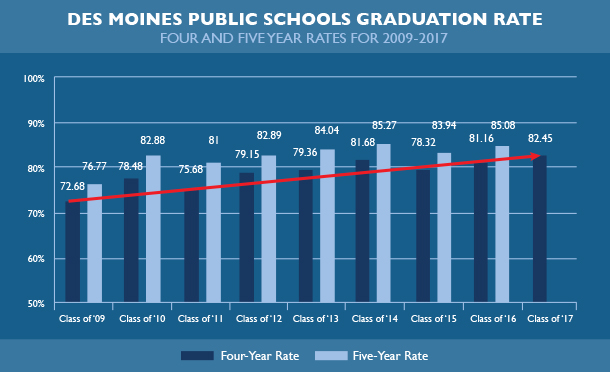Graduation rate data released today by the Iowa Department of Education shows the Class of 2017 at Des Moines Public Schools hit a new high, with the largest percentage of graduates since the state began using its current graduation rate formula nine years ago. The graduation rate at DMPS has increased nearly ten percentage points during that time.
The Class of 2017 at Des Moines Public Schools had a district-wide graduation rate of 82.45%, an increase of 1.29% over the previous year. The four-year graduation rate for the Class of 2017 at the district’s five comprehensive high schools – East, Hoover, Lincoln, North and Roosevelt – was 88.81%, up from 87.67% for the Class of 2016, and also a new high mark for those five schools.
Statewide figures show a slight drop in the percentage of Iowa high school students who completed high school in four years, with a statewide graduation rate of 91.0% for 2017 compared to 91.3% in 2016.
The five-year graduation rate was also released today. The district-wide five-year graduation rate for that Class of 2016 at Des Moines Public Schools was 85.08%, up from 83.54% for the Class of 2015.
Statewide figures show an overall increase in the percentage of Iowa high school students who completed high school in five years, with a five-year rate of 93.4% for the Class of 2016 compared to 93.3% percent for the Class of 2015.
The following chart shows the graduation rate trend at DMPS over the past nine years:
 Since 2009 graduation rates in Iowa have been calculated using a formula established by the U.S. Department of Education. Unique student identification numbers are assigned to ninth-grade students, allowing school districts to account for all students as they move through high school. At the state level, the method helps determine when a student graduates, even if the student has moved to a different district in Iowa during high school. The graduation rate for Des Moines Public Schools has increased nearly 10 percentage points since the State of Iowa first started using this formula.
Since 2009 graduation rates in Iowa have been calculated using a formula established by the U.S. Department of Education. Unique student identification numbers are assigned to ninth-grade students, allowing school districts to account for all students as they move through high school. At the state level, the method helps determine when a student graduates, even if the student has moved to a different district in Iowa during high school. The graduation rate for Des Moines Public Schools has increased nearly 10 percentage points since the State of Iowa first started using this formula.
“At a time when state and national leaders are undercutting public education – despite the fact we serve nearly 94% of Iowa’s students – time and again we are showing a growing route to success in our schools and classrooms,” said Dr. Thomas Ahart, superintendent of Des Moines Public Schools. “Our focus is to continue that growth in a way that is equitable, helping all students succeed in earning their diploma.”
The Iowa Department of Education also released annual dropout rates today. The Des Moines Public Schools grade 7-12 dropout rate for 2016-17 was 5.12%, and the grade 9-12 rate was 7.52%. These rates reflects the percentage of students who drop out of school during a single year. DMPS is committed to re-engaging these students so they may continue on their path towards a high school diploma.
DMPS has begun several initiatives in recent years that have contributed to raising the graduation rate, including:
- In the fall of 2009, DMPS implemented the Early Indicator System (EIS) to help identify students who may be at risk of dropping out of school. The EIS tracks attendance, class performance, and discipline/behavior issues at the elementary and secondary levels. In addition, each high school now has an Academic Support Lab to help serve students who are identified through the EIS as at-risk for dropping out of school.
- Also in 2009, DMPS began the Graduation Walk, a grassroots effort done in partnership with United Way of Central Iowa to raise community awareness about the importance of completing a high school diploma as well as to reach out to recent dropouts and students falling behind to make them aware of available support. Thanks to hundreds of volunteers, the program has knocked on thousands of doors over the past eight years and was presented with the 2015 Magna Award by the National School Boards Association.
- Over the past several years DMPS has greatly expanded access to Advanced Placement courses, with new AP courses at Central Academy and a more complete AP curriculum offered at all five high schools. During that time AP enrollment has quadrupled and participation in AP exams has doubled, raising expectations for academic success throughout all high schools.
- Senior Summer School was developed as a 9-week intensive credit recovery program targeting 12th graders who do not graduate by the end of the regular school year due to credit deficiencies. Programming consists of both academic and social support for students, with the goal of increasing the number of students who meet credit requirements for graduation by the end of the program. A graduation ceremony for students who successfully complete the program is held in August.
- DMPS has significantly increased afterschool programming and extracurricular activities at all middle schools, and is beginning similar efforts at the elementary school level, in order to help students become more connected and engaged with their schools.
- For the past five years DMPS has worked with the Gallup Organization, utilizing the Gallup Student Poll, which provides data on our students’ levels of hope, well-being and engagement and helping the district develop more purposeful and student-focused school improvement plans.





